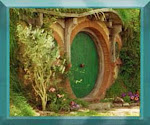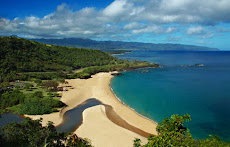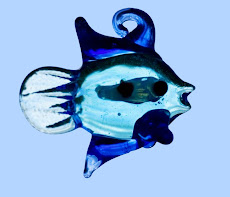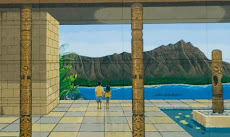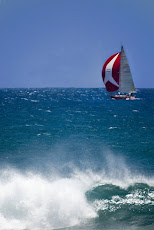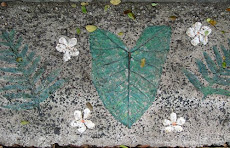|
|
| |
| (Many Paths) | ||
| An Online Newsletter Celebrating Native America | ||
| February 9, 2002 - Issue 54 | ||
|
| ||
| Following the Footsteps of His Grandfather | ||
| by Suzanne Westerly Canku Ota Correspondent | ||
| Photos of Roscoe and Eagle Young by Suzanne Westerly |
 "I got my big break as a dancer, and I worked my way into acting because it was my big dream, to act. I really love it here in Hollywood, it was something I always wanted," said Roscoe Pond smiling. Sitting outside on a breezy balcony in a restaurant at the Beverly Connection, a shopping center on the edge of Beverly Hills, Roscoe talked about his journey to Hollywood. Roscoe's life revolves around auditioning for (and getting some) acting roles, dancing and writing, while also working in an exciting new Southern California Indian Center (SCIC) Employment and Training (E&T) Program in audio/visual production. "It's been a long road, but it's been a really good learning experience," he said in his soft deep voice as he sipped some water. "I got my big break as a dancer, and I worked my way into acting because it was my big dream, to act. I really love it here in Hollywood, it was something I always wanted," said Roscoe Pond smiling. Sitting outside on a breezy balcony in a restaurant at the Beverly Connection, a shopping center on the edge of Beverly Hills, Roscoe talked about his journey to Hollywood. Roscoe's life revolves around auditioning for (and getting some) acting roles, dancing and writing, while also working in an exciting new Southern California Indian Center (SCIC) Employment and Training (E&T) Program in audio/visual production. "It's been a long road, but it's been a really good learning experience," he said in his soft deep voice as he sipped some water. At the early age of ten, Roscoe found happiness singing and acting while his brothers and sister found happiness playing sports. A member of the Confederated Tribes of Umatilla, Walla Walla and Cayuse People, Roscoe Patrick Pond, was a young boy with a dream and a lot of determination. Knowing how his son felt, one-day Roscoe's dad said to him, "if you want to perform, and if you want to see what it ís like out there, you should go [to the Chemawa Indian School]." I said, "okay I will. Actually, it was my grandfather's idea, and that's how my life began," said Roscoe. Roscoe's grandfather wanted his son to go to the same boarding school that he went to, the Chemawa Indian School in Salem, Oregon, but unlike his father, Roscoe's dad didn't want to leave the Reservation. Roscoe, though, was more like his jazz musician grandfather whose dreams were interrupted by WWII. Like his grandfather, Roscoe knew that leaving the reservation was the first step toward realizing his goals. Adventure and music beckoned him as it had his grandfather. After graduating from Portland State University, Roscoe headed for New Mexico, where he joined the DayStar Dance Company run by Rosalie M. Jones. "I was with Daystar from 1990 - 1997. "Then I graduated from dancer to actor, then lead actor." On the road performing with Daystar, a chance meeting changed his life. The Last of the Mohicans (starring Wes Studi) was being filmed in South Carolina. That was Roscoe’s his first audition for a Hollywood film. Although he didn't get a role, it was his start in "the business." Roscoe arrives in Hollywood In 1998 Roscoe found an agent. After being with her for a year "she asked me to get all my hair cut off, It was down to my lower back." She felt his long hair only allowed him to be in Native American roles. What about tradition? "Our people didn't have long hair. Except for my great great granduncle, who was a chief of the Umatilla's in the 1930's.” Roscoe didn't want to cut his hair, but he did. "So if I go on a Native American audition I can put the wig on and 'look' Native American. I just had to compromise, and that's what you have to do sometimes." Southern California Indian Center Employment and Training Program (see sidebar) SCIC and Eyapaha Institute (see sidebar) had formed a partnership to build a program that would teach all aspects of the film industry to Native Americans. Chuck Banner, Director of Entertainment & Multi-Media of the Eyapaha Institute and the Senior VP of Production & Development at Red Crow Creations is the curriculum's project director. The program includes learning "everything that goes with filming, producing and editing movies, ... including computer training. ... I never knew anything about computers until a year ago, and now I am just flourishing," Roscoe remarked with a grin.
What worked for Roscoe? Roscoe loves to learn. "An education at a major university was just incredible and it really did push me into what I wanted to do, you just can't ever let go of learning." Also of importance to Roscoe is health. "It all comes down to what you're eating and drinking. I'm finding out that drinking water, about five glasses a day is important. Pop has so much sugar; it's so bad, like alcohol. Water is good," he said as he finished his glass of water and eagerly headed off for an audition.
Photojournalist POB 564 Malibu, CA 90265 mobile, 310-924-5522 |
|
| ||
|
| ||
| Canku Ota is a free Newsletter celebrating Native America, its traditions and accomplishments . We do not provide subscriber or visitor names to anyone. Some articles presented in Canku Ota may contain copyright material. We have received appropriate permissions for republishing any articles. Material appearing here is distributed without profit or monetary gain to those who have expressed an interest. This is in accordance with Title 17 U.S.C. section 107. | ||
| Canku Ota is a copyright © 2000, 2001, 2002 of Vicki Lockard and Paul Barry. | ||
|
|
| |
| The "Canku Ota - A Newsletter Celebrating Native America" web site and its design is the | ||
| Copyright © 1999, 2000, 2001, 2002 of Paul C. Barry. | ||
| All Rights Reserved. | ||


 Roscoe didn't know anyone when he first got to Hollywood, so like many struggling actors, he found a job in the fast-food industry. He later discovered there was a lot of help for Native Americans in LA. (See sidebar)
Roscoe didn't know anyone when he first got to Hollywood, so like many struggling actors, he found a job in the fast-food industry. He later discovered there was a lot of help for Native Americans in LA. (See sidebar)  Roscoe and Eagle Young (from Taos Pueblo, NM), also an actor, are the first two trainees in this new program. "We got to film all the Indian activities at SCIC, including the PowWow, projects like the FAITA (First Americans in the Arts) Awards web cast, and Floyd's (Red Crow Westerman) gala for "The Hoop of Life." Besides taping, Roscoe and Eagle also do the editing. "Paula Starr, the Executive Director of SCIC has been really supportive of us, and I am very thankful to her for that," said Roscoe enthusiastically.
Roscoe and Eagle Young (from Taos Pueblo, NM), also an actor, are the first two trainees in this new program. "We got to film all the Indian activities at SCIC, including the PowWow, projects like the FAITA (First Americans in the Arts) Awards web cast, and Floyd's (Red Crow Westerman) gala for "The Hoop of Life." Besides taping, Roscoe and Eagle also do the editing. "Paula Starr, the Executive Director of SCIC has been really supportive of us, and I am very thankful to her for that," said Roscoe enthusiastically. 